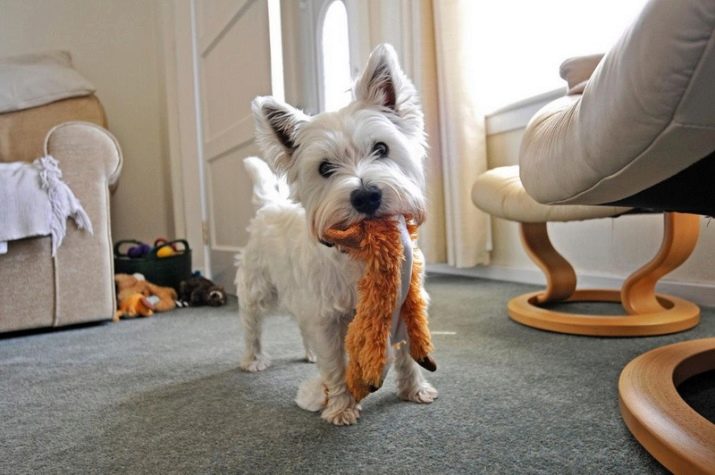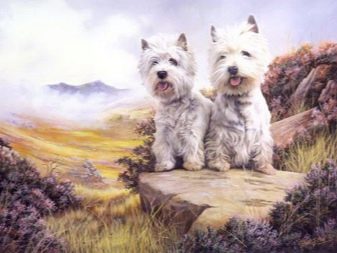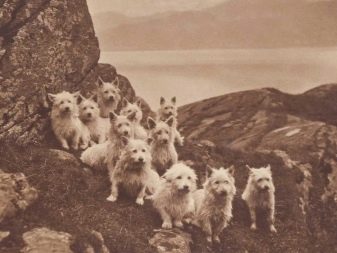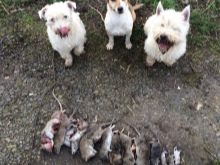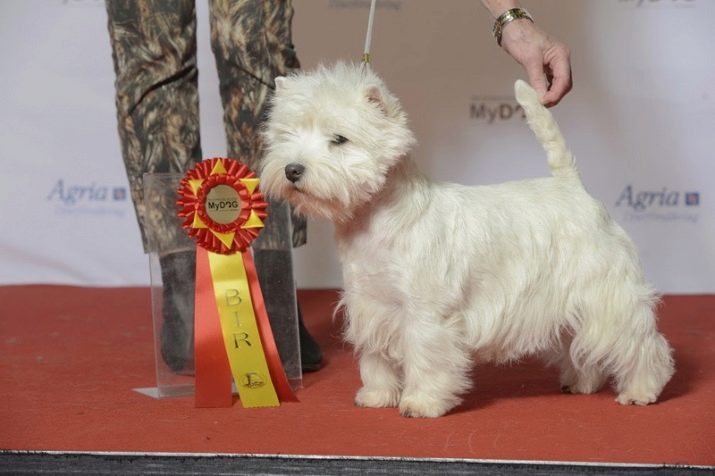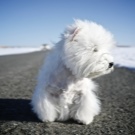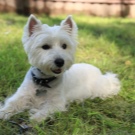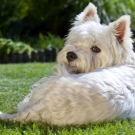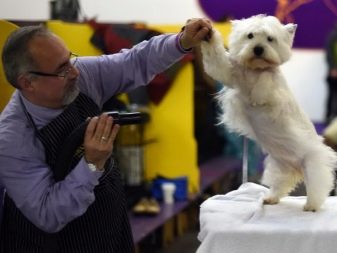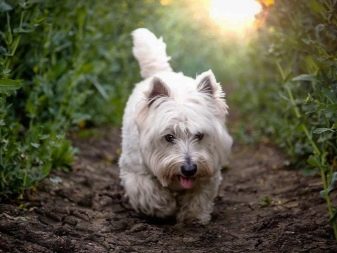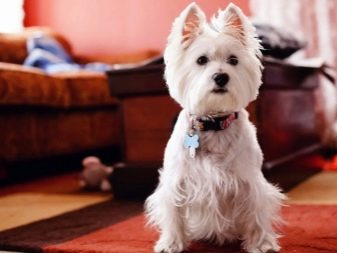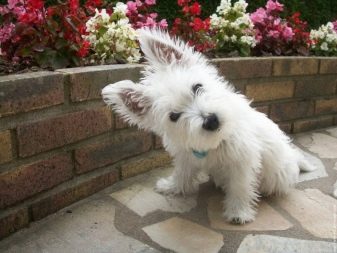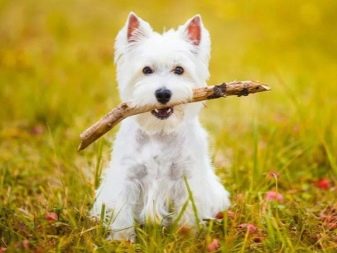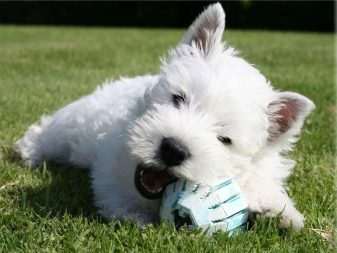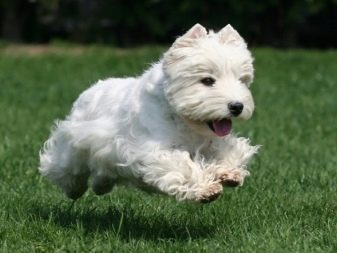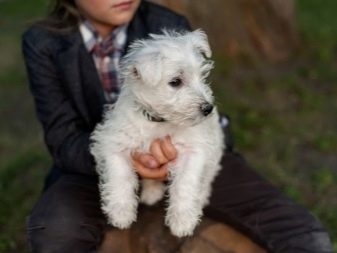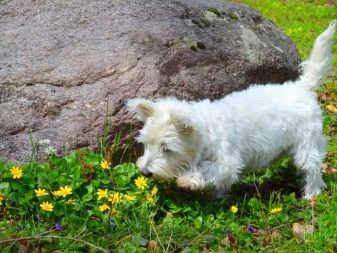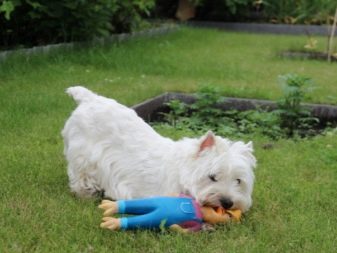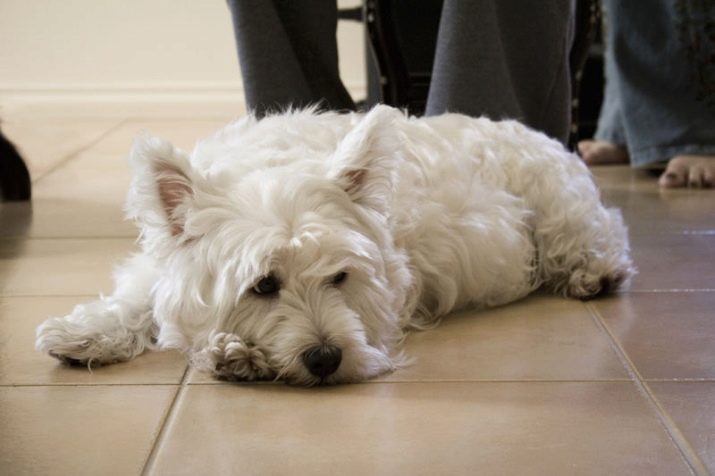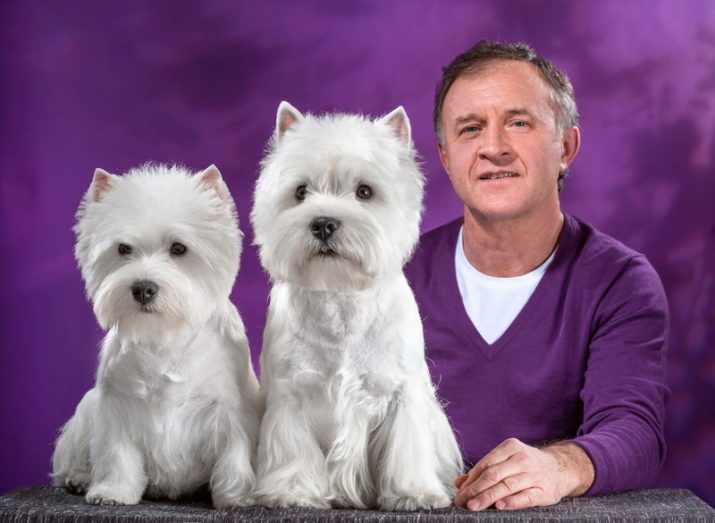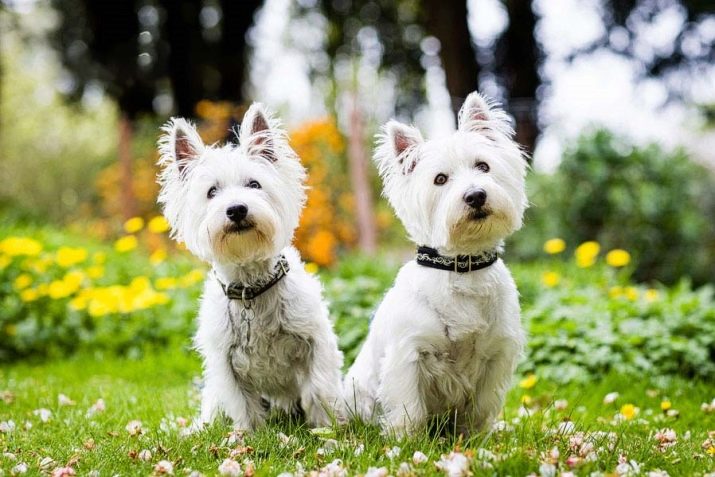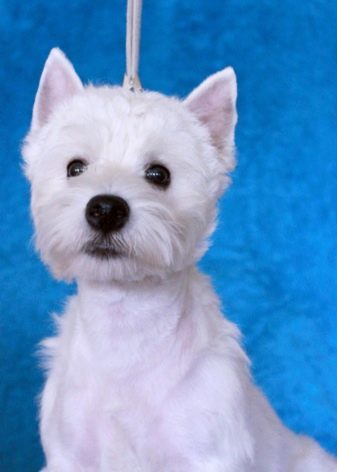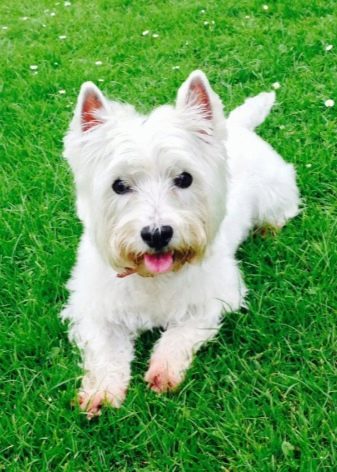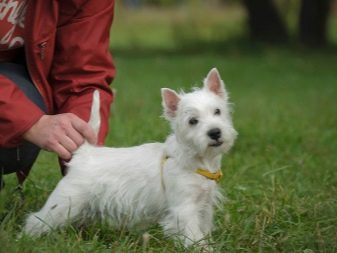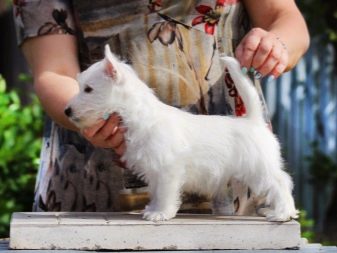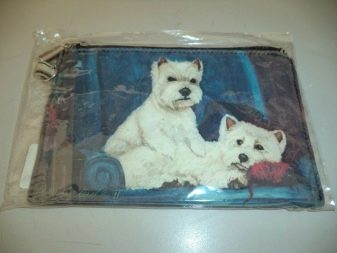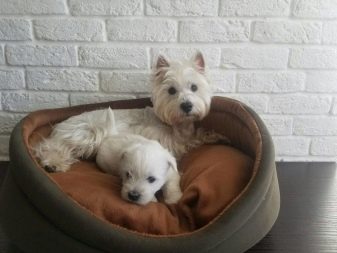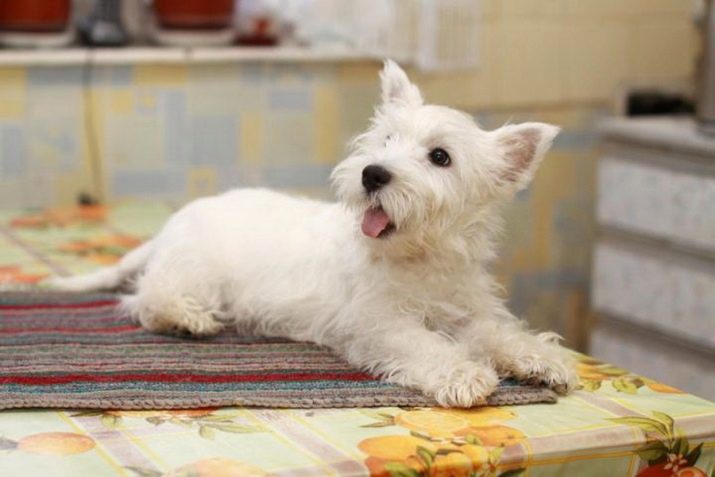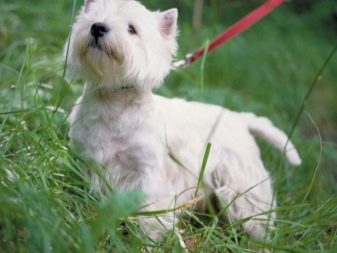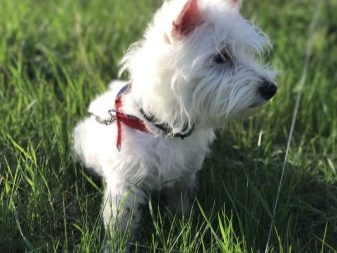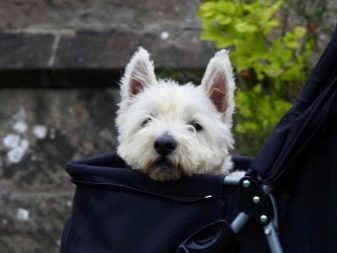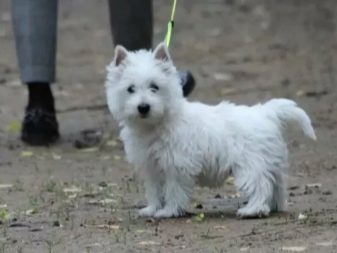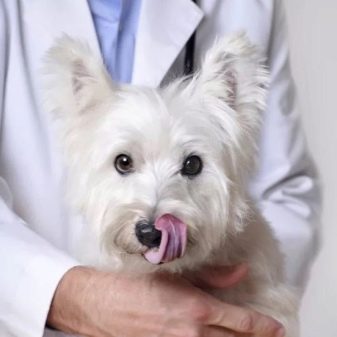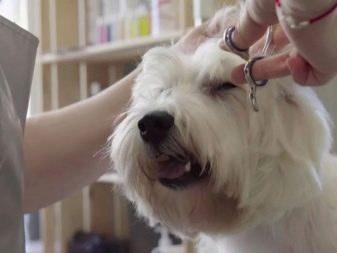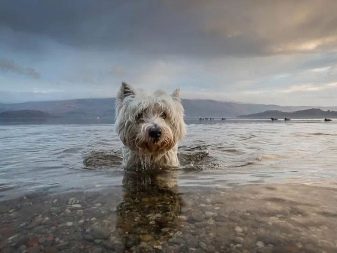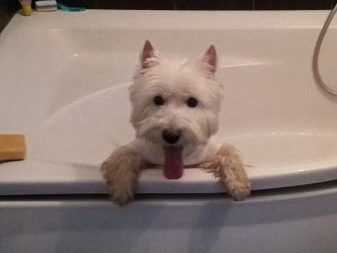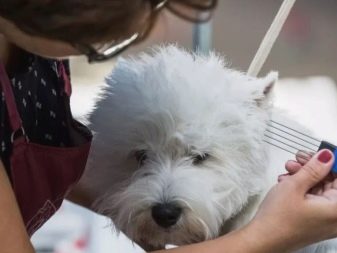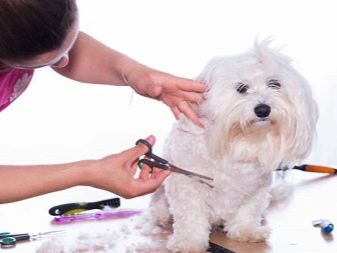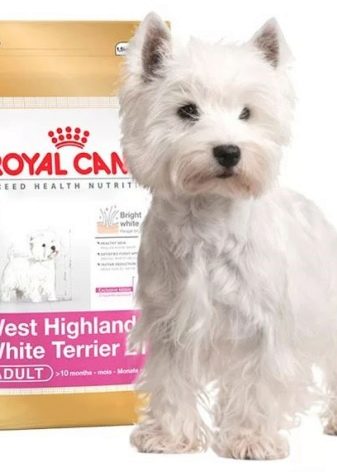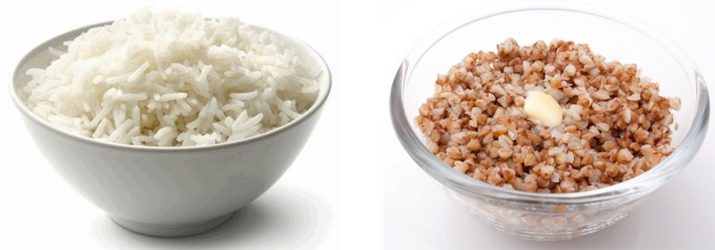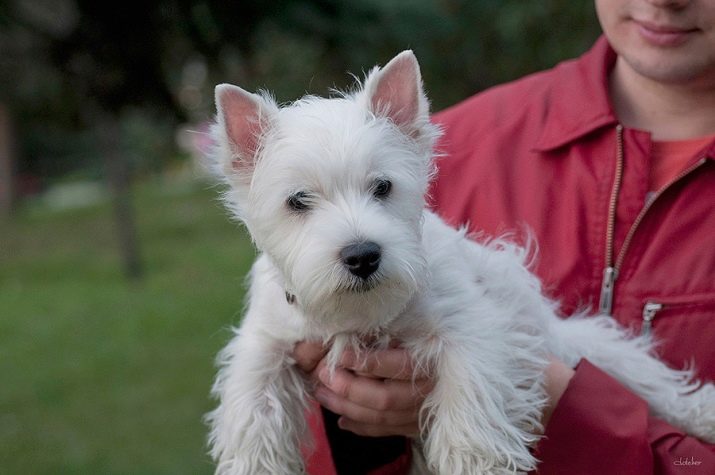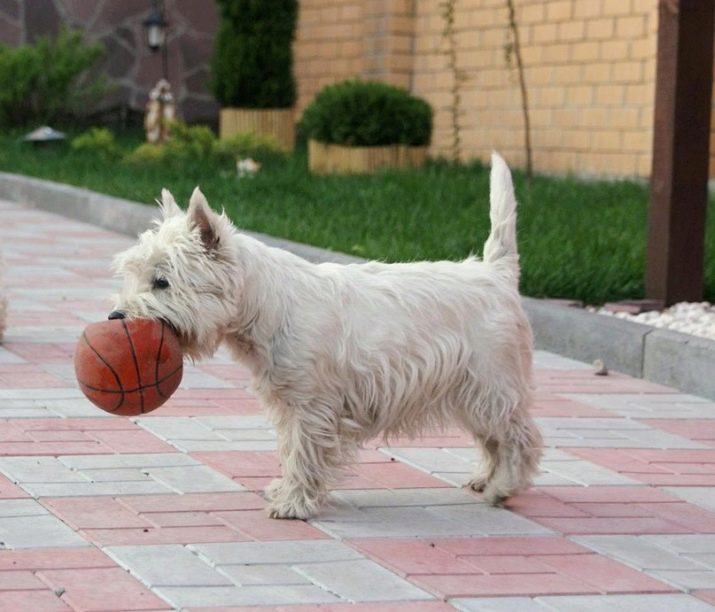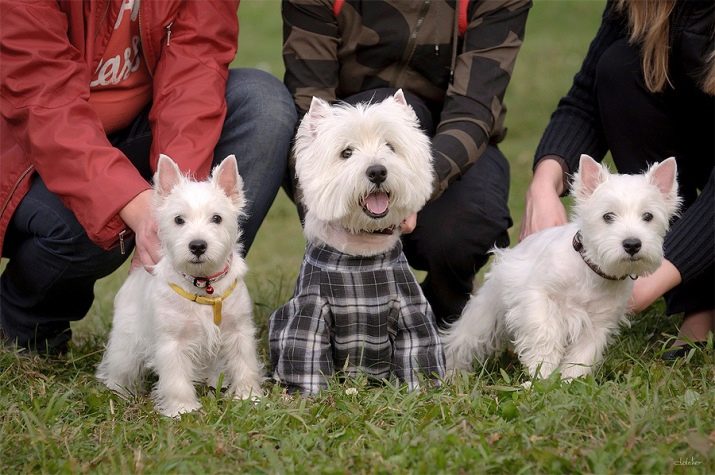There are many species, species, subspecies, varieties of dogs known in the world. Each has its pros and cons. But the answer to the question of why a person starts a particular dog is also different. It is more interesting to know how and why the west highland white terrier appeared - a snow-white dog in the mountains of northwestern Scotland.
History of origin
To tell about the appearance of the West Highland White Terrier, you need to remember the history of dog breeding before the XI century, it was then that the first mention of terriers appeared. “Terra” is translated as “earth”, that is, literally terriers are earth dogs. These are hunters who are digging in the ground, burrows, looking for a badger, fox, otter. And when they find them, they drive them out or drive them into a corner and wait for the owner, the hunter. So these small, active dogs that chased prey through shrubs and rocky crevices, described as early as the XI century.
In 1576, John Kayus, the court doctor of the Queen of England Elizabeth I, mentioned in his story “About the English Dogs” that terriers do an excellent job with rodents, and they are good at normal hunting. In 1830, John Leslie wrote colorfully in his book about how earth dogs "put badgers and foxes to flight".
I must say that at that time there were already many different types of terriers. They differed in color, the structure of the coat (dog), the shape and position of the ears. In addition, they were divided into short-legged and long-legged. For the most part, the breed is the result of a cross. The same applies to the West Highland White Terrier. There are two assumptions about their appearance: either its ancestor was a kern terrier, or a scotch terrier. But it was precisely in Scotland that white Kutiats appeared in the litter, which they tried to destroy, so as not to spoil the breed (they were convinced that puppies of the light color are physically weaker, they suffer more).
At the end of the 19th century, Colonel Donald Malcolm from Poltalloh, Argyleshir, on the hunt, shot his beloved red terrier on a hunt, confusing it with a fox. This case forced him to remember the white terriers of the White Terriers. But they would be clearly visible in the mountains, on the rocks, and in the fields. This was the starting point for breeding work on the breeding of white terriers. Then they were called poltallokh-terriers.
At the turn of the century, Malcolm presented his white dog dogs, naming them the West Highland White Terrier. Almost 10 years later, a club appeared representing the interests of a new type of terrier. After another 3 years, they took part in the exhibition of breeds, after which they quickly began to gain popularity, and not only among hunters. In 1908, the Kennel Club, an American Kennel Club, registered the first representatives of the breed in its registry. This was a real victory for the White West from the highlands of Scotland.
Thanks to Donald Malcolm, Duke of Argilles of Roznit, Dr. Flaksman of Fayfshir, breeder May Pasy, we now see the West Highland White Terriers as they are.
But the breeding work continued. In 1924, breeders were forbidden to exhibit dogs - mixes with other breeds of the terrier group. This is how the unique exterior of the white terriers was formed. And only at the end of 1954, the West Highland White Terrier was registered by the international canine society as an independent breed.
In the late 90s of the 20th century, the inhabitants of the Soviet Union were able to acquire westa in their homes. He was still used for foxing or badger hunting, but gradually the dog was started as a companion, as her temper was very docile and her appearance was unusual.
Description
Today, the West Highlands are defined by the standard of the International Canine Federation FCI No. 85, where all the characteristics are clearly stated, in which the west highland white terrier belongs to section 2 of group 3 (small terriers).
- A purebred individual is distinguished by a firmly folded body, endowed with a flat line of the back, strong croup, and sinewy limbs under a broad chest. We will have a moving temperament (if we were talking about a person, you would say that he is a sanguine person). Dog bold, active, strong. For restlessness dignity and stubbornness are hidden. Moreover, the white terrier seems carefree, but wary, he is friendly with everyone, but he stands up for the owner, without hesitation.
- There is a dense dog on the head, the skull is parallel to the ground and perpendicular to the cervical vertebrae. The distance between the occiput and the ocular cavities is slightly larger than the length of the muzzle. Black, not protruding nose. The head is already from eye to nose. Thanks to the widely spaced canines in strong, flat jaws, it seems that the West smiles slyly. The upper row of large teeth tightly covers the bottom.
- Eyes of medium size, slightly elongated, dark, widely spaced from the nose. The West Highlands have a clever gaze that penetrates from beneath the looming eyebrows into the eye of the beholder. Light eyes are considered a flaw.
- The ears are pointed, small, easy to stand straight, planted on the head very proportionally. Ears are covered with short and soft, velvety hair, according to the standards it can not be clipped. On the ears there is no fringe. According to the standard, a dog should not have round, big, thick ears. Also, the retreat is considered a large number of hairs on the ears.
- Neck due to its length ensures the correct position of the head. The neck smoothly passes into the sloping shoulders, thickening towards the base.
- The body is dense, compressed, with a straight back, powerful croup and a broad chest.
- The tail is not particularly long - 12.5-15 cm (do not stop), with hard dog, without fringe. It should be located almost parallel to the ground or rise a little higher, not to fall backwards.
- Limbs strong, sinewy, short, straight. They are covered with a thick short tough dog. The hips are very muscular. Paws strong, front more than the rear. The pads are thick, protected by a short stiff coat. According to the standard, it is desirable that the paws with claws be black.
- Gait flying, free. Thanks to the well-bending joints, the west can be pushed forward a lot while jumping.
- The dog is two-layered: undercoat with short, soft, dense coat, and the outer layer, 5 centimeters long, hard. Curls according to the standard should not be, as well as non-adherent wool.
- The color is white, due to external factors, it is rather unstable, therefore a yellowish tint may occur.
- The size determined by the height of the withers is about 28 cm. Experts explain that females can reach 23-28 cm and males 25-30 cm at the withers.
- The standards do not define the weight of the West Highland White Terrier, but in females it can reach 6-7 kg, and in males - 7-10 kg.
The difference between a pedigree dog and a designer dog is that if the breed does not meet the standards, then breeders will at least not receive documents for such an individual. If you acquire a dog, hoping for further participation in exhibitions, then you need to know that the exhibition assessment will be reduced by wavy or curly hair, non-standard ears, neck of atypical length, improper set of limbs. But if the dog shows causeless aggression and cowardice or it has too obvious physiological and behavioral defects, then it will not be allowed before the competition.
If the future owner is not interested in the documents, then he should know that because of its small size the dog is quite suitable for living in an apartment, but it has so much energy that it takes a lot of walking with it, giving it an active load. "Nedogul" she compensates for gnawed and rasporoshennymi things in the house.
This terrier has a very delicate scent, which is very helpful to rescuers in finding people, especially in narrow, hard-to-reach places. But this means that the house should not be used sharp odors in order to protect the nose of a hunting dog.
The intelligence level of vestics is quite high. This quality in combination with smart eyes will convince anyone that your pet understands you from a half-look. But for this he needs to be raised and become his friend.
Answering the question, is a good Highland guard and caretaker, I must say no. Natural curiosity, good nature, lack of aggression do not contribute to the title of bodyguard. But as a sound alarm button is quite a suitable breed.
Character traits
Not only thanks to external data, but also to its character, Vestik earned itself a good name. He is a real actor loved by directors of feature films, documentaries and commercials. This suggests that the dog has a high level of ingenuity. At the same time, pets are very curious and restless, at any age they remain young adventurers. The main negative habit is the desire to "get to the bottom of the truth", and he will dig both on the street and at home.
The reasons for this behavior in the inexhaustible energy. To cope with this problem, West must be brought up from an early age. And here, the main thing with which the owner will have to face is the natural stubbornness stated in the standard.
Only when you succeed in winning the trust of your companion, does the dog recognize the leader in you. The more you put pressure on him, the more uncontrollable it will be.
If the dog is raised, then it is peaceful enough, sociable, ready to travel. Be careful with other animals: the news is quite jealous. If it is possible to make sure that the animals get along with each other, then it is better to introduce them in advance. Otherwise, in a fit of jealousy, he can throw himself at the hamster, as well as at the alabaya. But with children, they are fully capable of coexisting if children are over 10 years old and see a friend in the dog.
And do not forget, I need movement: dog sport, walking, hunting. This being is clearly aware that movement is life. Moreover, at this moment the dog is not alone, but for him it is important. These terriers do not like loneliness, although they can spend some time without owners. No matter how large the family is, the dog will have one owner, he will raise and feed. All other family members are neighbors with whom the news will be friendly.
Pros and cons of breed
Vesta is called a restless and cheerful dog that just needs attention. Sonorous, but not nasty voice, will help to learn about the arrival of guests. He loves to bark, but most of all he likes to dig - the hunting genes have an effect. Living in a private house at the cottage can result in the loss of beds and flower beds. To avoid this, you need to select the territory where the heap will be unloaded (sand, leaves, old safe things, toys). It is also good to equip a sports ground for training. The more busy the dog, the less you have problems.
If we talk about care, the main plus and at the same time, the minus is white beautiful wool. After all, temperamental dog on the street is difficult to remain white, and this is an additional concern for the owners - to wash, dry, comb. And so after each walk.
Another disadvantage is the desire to win a place near the host: jealousy forces him to fight with both rodents and large animals. At the same time for the owner, he is ready for much, very attached to him.A mischievous character and appearance of soft toys make him a universal favorite.
Lifespan
Like all pets, the life of the West Highland White Terrier depends on the conditions of detention. Due to the nature, not only the number of square meters, quality nutrition, veterinary care, but also communication with family members are important here. Alone, the dog will yearn and will not live long. With good care, Vestika live up to 13 - 15 years.
Varieties
West Highland itself is a variety of terriers. There are no subspecies inside the breed. But there is a classification for participation in dog competitions, starting from 3 months of age. There are also class differences. Professional breeders can easily determine what class a small terrier belongs to.
- Show- and Top-class. These are the best puppies in the litter, in the future they may be the winners of the shows. Physiologically, they are 100% compliant with FCI No 85. Minimal deficiencies are possible, but breed defects are not allowed. Usually such puppies are born champion parents. This is the breed standard, determined by the highest price. But to buy such a baby is almost impossible - breeders will probably keep it for themselves for later breeding.
- Breed class - A category that includes healthy white terriers with an excellent pedigree and good data to reproduce offspring. For this class, it is important to correctly select a pair. If you do this correctly, you can get the offspring of the show class. Most often, a bitch is considered to be a breeded class, and males with very close characteristics are referred to the lower Pet class. The brides have an exhibition temperament.
- Pet class - these are rejected puppies that have inconsistencies with breed standards: wrong color, defective wool, breed defects (the life of a dog is not threatened, but can badly affect offspring). Animals of this class can not participate not only in exhibitions, but also breeding. This fact is indicated in the accompanying documents. Also pet-class puppies belong to unscheduled mating.
How to choose a puppy?
The decision to get a puppy for many rests on the question of why it is acquired: if for breeding, exhibitions, the criteria for the purchase will be very different from those when you get yourself a companion or hunting dog. Having decided to pay attention to certain aspects.
- Regardless of the country, choose kennels that are registered in canine federations. Use the tips of familiar owners of West Highland White Terriers, reviews of the kennel. In good places, almost all matings are planned, which means the baby will be with documents.
- Do not rush to buy a puppy from the first acquaintance. It is better to watch a few litters from different parents. Each dog has its own character, habits, appearance.
- Specialists have the term "breeders", and there are "breeders". Breeders will help you with advice throughout the maturity of a puppy. The task of the breeders is to sell the goods. Before buying, you should ask whether the nursery provides consulting services and under what conditions.
- The conditions that contain puppies and their parents in the nursery will tell you a lot. Insanitary conditions in cages can haunt your pet with diseases acquired in the first days of life. If the dogs have a large enough area in which they move freely, cleanliness in the pens, then to such a place of sale of puppies and trust increases.
- It is believed that girls are more trainable, but Vesti is not so: dogs study faster. The nature and intellectual abilities of the puppy's floor have almost no effect.
- At the time of choosing a pet, try to assess its physical condition: the puppy should not be lethargic, but should confidently hold on to its paws. Experienced dog breeders recommend paying attention not to the largest in the litter, but the most nimble.Feel the navel area: there should be no swelling and protrusion of the abdomen - these are signs of health problems. Eyes baby should be clean, without discharge. The nose is clean and moist, the ears are pink. Under the tail of the puppy should not be a trace of liquid stool.
- Perhaps, like all breeds, there may be genetic diseases. Before viscous parents are tested. Do not be lazy to ask the breeder test results. This is not a 100% guarantee that your baby will not have problems with it, but the absence of diseases in parents dramatically reduces the risk of disease in a puppy.
- The representative of the Show-class costs about 40,000 rubles. But if you take a puppy only for the soul, and not for exhibitions and competitions, then you can look for a dog much cheaper without documents. But to be sure that you buy West, be like exhibitions, get acquainted with the breeders and use their advice in choosing a pet.
- Visiting shows prior to shopping will also give you a wealth of information on how to care for, feed, and raise a puppy. If there are children in the house, it is very useful to take them to such events.
- Experts recommend to pay attention to the bite of the dog: the upper jaw is at the bottom, from below and above there should be 6 incisors and 2 canines.
- With or without documents you take a dog, it should already have a veterinary passport, in which information about the vaccinations made. With this passport you will continue to visit your veterinarian to continue the vaccination.
Maintenance and care
Before the baby gets into your home, he needs to prepare places to sleep and play, to eat and to use the toilet. And if at first these zones can be located next to each other, then the older the puppy, the faster it should be taught the functionality of each zone.
- For sleep and games, it is desirable to purchase a dog basket or warm bedding. A puppy should have toys: rubber, silicone or wooden. Carefully monitor the quality and the individual elements of toys: they should not have a strong chemical smell and small details - everything is like in children. If there are no more furry animals in the house with which the puppy would express a desire to sleep, then buy him a soft toy under his side.
- For food you will need 2-3 bowls: for dry food, for natural food, for water. It is better to put bowls right where the dog will always eat. They should not interfere with your feet. And be prepared for the fact that there will always be a little around them, but it is dirty: do not forget to clean up the area after each feeding of the dog, and also wipe the terrier's muzzle with a damp napkin. If this is not done, the remains of food will be stuck in the wool and will gradually dye it in different colors.
- To cope with the natural needs, at first, the queen will need a diaper - impermeable. Most likely, at first it will be located next to the bed, but gradually you will move it to the place where the tray will stand. If you have acquired a sufficiently adult puppy, which is accustomed to the toilet, the breeder will tell you how to teach the puppy to the place-toilet in your home.
After the puppy settles down in the house, you will have to teach him to bathing, cutting, walking, combing. If you are preparing an exhibition dog, you will often have to visit a groomer. If not, then the named procedures are performed at regular intervals.
Walking
For our active dog this is the main thing after eating and sleeping. From 3 to 6 months, Vestika is taken out (not taken out) for a walk 5-6 times a day in order to teach them to relieve themselves on the street. This can be done only after scheduled vaccinations and weekly quarantine. For those who do not have the opportunity to go out with the dog so often, waterproof diapers will help. The necessary minimum of walks for an adult dog is twice a day for half an hour, regardless of the snow and heat, the owner’s indisposition and other problems.
But the West is ready to walk much longer if it is a sports ground or, as was said earlier, an artificially created pile of autumn leaves, toys, etc. A leisurely walk on a harness next to an elderly person is not what the West needs. But as soon as the dog was let off the leash, it pranks from the abundance of odors and the ability to rummage in all sorts of heaps and becomes unmanageable. If there is a sports town or a room for dogs, then the West will gladly join the Agility and Freestyle.
For a walk, some owners wear a West Highland White Terrier in poonok, overalls and other bright clothes. There are two reasons: to demonstrate your handsome, protect from dirt. In any case, the dog does not need warming. Even in the winter during the walk, it will not freeze, because it is constantly in motion.
General hygiene
Teeth should be cleaned twice a week. To maintain them in good condition in the diet should be solid foods - abrasives, and you can buy bone-toothpicks. Eyes need to be inspected daily. The presence of brown stains under the eyes is considered a sign of allergy - you should immediately contact your veterinarian. Once a week they clean their ears, pluck out long hair inside the ear.
Claws with intensive street load can erase themselves, if this does not happen or the dog is exhibition, then the claws need to be trimmed. Pads after each walk must be washed. If it is cold outside and the tracks are also sprinkled with reagents, then after the walk and washing of the paws, the pads are smeared with a nourishing cream. So that the wool does not interfere with the dog, as well as to maintain hygiene, shears hair covering around the anus and genitals.
Bathing
Opponents of frequent bathing dogs recommend washing them once every 6 months in order not to wash the protective fat layer off the body and coat. With regard to Vesta, this is hardly possible - white wool should be washed at least once a month, and after the street - of necessity. For washing, they use zoo shampoos, whitening shampoos (not for puppies!), As a last resort - children's shampoos. In general, they need detergents for hard-haired dogs.
Combing out
West sheds a bit, but during the molting period, it should be combed out every day, every 2-3 days. Very good for this procedure suitable furminator. It is recommended to use a metal brush with sparse teeth in order not to tear the fur. The procedure for the dog is pleasant, as it removes dead hair, pieces of dirt, and spikes from a street walk. Soft wool is recommended to be combed more often to avoid tangles.
Extra care for the fur coat
To preserve the color of the coat and remove its yellowness, it is recommended to clean it with a mixture of crushed chalk and boric acid. The product is rubbed into a slightly damp wool, and then combed out with a regular brush.
A haircut
If you want to mow the dog shortly, then you can do it yourself and typewriter. A good haircut your dog will make a groomer. Grooming is required for show dogs. But the professionals say that due to the stiffness of the hair coat, the white terrier does not need a haircut, but trimming. The procedure of plucking dead hair is more useful, as they interfere with the dog, stuck among the living hair.
When shearing, the dead hair remains on the body of the dog, does not allow new hairs to grow. Over time, the quality of the meat deteriorates, it becomes thinner, falls, fades. It is recommended to trim a pet dog once in 2 months, an exhibition dog once a month.
What to feed?
The owner can choose to feed his dry food, natural products, or both, and others. But what the dog chooses, you can find out only with time. Therefore, when you enter a new dish, you should not use several new products at once, otherwise it is not clear what exactly the West liked or did not like.
When buying dry food you should choose super-premium and premium-class feed.They will be the rescue for dogs with allergies and diabetes. The following products are recommended for natural nutrition:
- lean boiled meat, except chicken (pork Vesta not feed), offal, cartilage;
- lean sea fish;
- buckwheat, rice, oatmeal (millet porridge, flour - banned);
- cottage cheese, kefir, sour cream;
- vegetables (except potatoes and onions) and fruits.
The number of feedings depends on the age of the west:
- up to 3 months - up to 6 times per day / serving size - 150 ml;
- 3-4 months - up to 4 times / 200-250 ml;
- 4-6 months - up to 3 times / 500 ml;
- 6-8 months - 2-3 times / 750-1000 ml;
- older than 8 months - 2 times / 1.5 l.
With natural feeding in the diet must contain vitamins. Forbidden foods include: smoked meats, spicy dishes, bird bones, pastries, nuts, sweets, food from the table.
Upbringing
The process of education begins with the appearance of a puppy in the house. It is necessary to accustom a very small newcomer to a diaper, an older one - to a tray or to ask him to go outside. How to do this, tell our video. It is always a pity for the little ones, and the owners often try to take the puppy in their arms, on the sofa, in their own bed.
Do not forget that in this way you form the habit of the beast. So when you are not at home, he will take a seat in your bed. If this is undesirable, then you should not take him to yourself while he is small.
As a smart dog, West clearly feels the strength and weakness of the owner. In order for the dog to fulfill your commands, you must earn his respect, be morally stronger than him. This is manifested in confidence, sequence of actions, perseverance. During the training, it is advisable to be alone with the dog, so you will make it clear who is the boss, and concentrate the attention of the beast. From about three months of age, while playing a puppy, you can teach the commands “to me”, “aport”. From 6-7 months of age, dogs are taught more difficult commands: “lie down”, “sit”, “fu”, “voice”, “give a paw”, “near”. To do this, you can contact the club of dog breeders or try to train yourself. The dog is interested to deal with the owner. If you see that the pet is distracted, switch attention to another team, a little later you will return to the initial one.
Teams are served clearly, calmly. With older dogs talking more strictly, but without crying. Any correct execution of the team is necessarily encouraged by intonation, stroking, sweets. Punishment is a change in intonation, but it is absolutely not a assault. Since the messages are very capricious creatures, it is impossible to lisp and indulge with them: weasel must always coexist with severity.
For training it is necessary to use:
- favorite toy ball;
- treats (dry food);
- harness or soft collar;
- long and short leashes.
For training in hunting skills, West is taken on a hunt in a pair with adult dogs, imitation of their relatives is the best way to learn.
Owner reviews
According to numerous reviews that are found on the Internet, we can conclude that the West Highland White Terrier is a true friend for loving owners. They characterize the West as a kind and affectionate dog that eats almost everything. The negative aspects of the content include caring for the coat, unwillingness to cooperate with young children, as well as those who encroach on the love of the owner. Hunters praise for courage, strength, endurance, energy. But they warn that it is necessary to deal with the dog regularly to overcome its stubbornness.
All about the breed of dogs West Highland White Terrier, see the next video.

